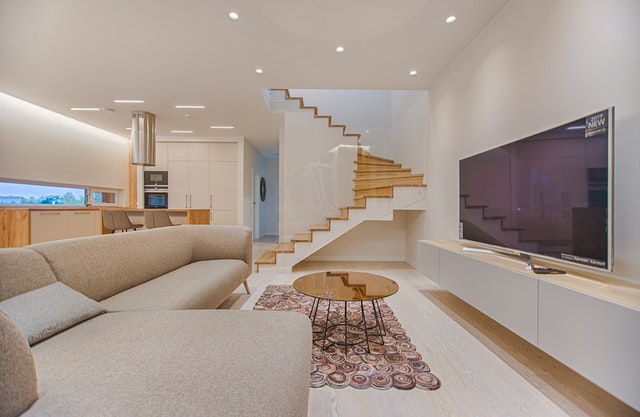| Just the Peaks
This newsletter, at a glance
|
It’s the year 2020—and smart tech has finally hit the mainstream
Before you start your next renovation project, keep this list in mind
These days, you don’t have to be a tech wizard to take advantage of in-home technology. For years, ‘smart home’ meant fancy lighting control, built-in entertainment systems, remote operated thermostats, and other stuff of the future.
But today, even the most basic home essentials have been transformed from manual to automatic, hard-wired to wireless, and complex to effortless. People who were once terrified of anything tech are now demanding the latest in-home gadgets. They not only provide amazing convenience, but also excellent cost savings.
So, whether you’re preparing for new construction, starting a renovation project, or searching for your forever home, consider bringing some smart tech onboard. With an ‘out with the old, in with the new’ mentality, you can easily increase your property’s value.
10 things your home doesn’t need anymore
- Telephone Jacks
Remember those old landline phones? How about the screeching sound of dial-up internet? Even though most houses still have jacks sprinkled throughout each room, mobile phones have made them more or less obsolete.
According to Statista, over 90% of adults had a functioning landline phone in 2004. Today, that number has shrunk to less than 40%.
- Computer Stations
A decade ago, hopeful homeowners were excited over those elaborate built-in workstations. You know, the ones with a shelf for the bulky big-screen and a sliding drawer for the keyboard and mouse.
With the popularity of laptops, wall-mounted monitors and sound bars, those computer cabinets are now useless. Here’s a better idea: install power outlets that also have USB ports for today’s many mobile devices.
- Manual Thermostats
Over the years, many homeowners graduated from the old-school slider style thermostats to slightly techier button versions. But those controls are still manual. If you leave for vacation and forget to set it, you’re out of luck.
Now, the latest smart thermostats have you covered, allowing you to raise and lower current temperature, set daily and weekly programs, and power the system on and off from anywhere in the world. Energy Star estimates that a smart or programmable thermostat saves homeowners up to $180 per year.
- Laminate Countertops
For decades, Laminate has been the popular choice for budget-friendly remodeling. But thanks to technological innovations in the production of building materials (as well as increased trade), the costs of sturdier, more appealing material has lowered significantly—allowing you to update your kitchen without spending a fortune.
Now, marble, granite, quartz can all be purchased for under $100 per square foot. For an even lower cost, look into recycled wood and bamboo countertops. Construction engineers have perfected the sealing process, making them more resistant to wear and tear than traditional wood tops and with less environmental impact—all with an average price of $40 per square foot.
- Wired Security Systems
For years, anxious homeowners relied on big, heavy, built-in home security systems, complete with the warning sign on the front lawn. Those alarms may have been effective, but they were also super expensive to maintain.
Instead of a subscription service, smart savers are now turning to DIY home security. Google Nest and other affordable smart systems allow homeowners, even those who are not so fluent in tech, to monitor their properties right on their phone.
- House Keys
No key? That’s correct. Contractors are now installing keyless door locks, which allow occupants to open doors either manually or electronically.
In some cases, the lock itself features a keypad, just like a home safe or garage door opener; anyone with the passcode may gain access. Other systems utilize virtual keys. This style lets homeowners open their doors via voice or smartphone. They also enjoy 24/7 activity logging and other handy perks.
- Water Heater Tanks
Growing up, if you ever shared a bathroom, you know what it’s like to run out of hot water. Today’s tankless water heaters finally eliminate those freezing cold showers, while also saving you a ton of money.
New instant water heaters use less electricity since water is not being heated when the house is empty. Not to mention, you’ll never have to worry about messy leaks or a flooded basement.
- Gas Style Ranges
For the longest time, gas stovetops were tremendously popular. They allowed for better temperature control, easier maintenance, and fast performance.
In the year 2020, you’d be surprised at how many home chefs are switching to induction cooktops. Modern families are looking for safety and energy savings, alongside all the perks of a gas range. Induction provides all of this, plus the convenience of effortless cleaning and cool-to-the-touch operation.
- Traditional Power Plugs & Strips
In order to power people’s growing collection of smart devices and electronics, quality power strips and outlets are crucial. Those old plugs get the job done, but today’s families want more.
The latest smart strips and sockets are energy efficient, Wi-Fi accessible, USB-integrated, and still relatively cheap. Users can control the flow of power via voice or smartphone—great for brewing your morning coffee from bed.
- Ding-Dong Doorbells
Just like the ‘beep beep’ of a car horn, fewer and fewer people are actually alerting friends and family of their arrival via doorbell. Text communication has become much more efficient.
That’s why Wi-Fi doorbells are everywhere. Systems like Ring and Blink are quick to install and feature both audio and video—so visitors are live-streamed to your smartphone. Unlike outdated doorbells, these smart versions also provide security.
Everest says: go ahead, get smart




